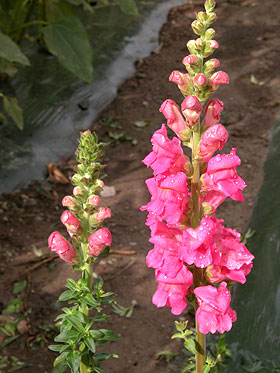
Antirrhinum majus
Propagation:
- Snapdragon is an annual grown from seed. Seedlings emerge in 7 to 14 days at room temperature.
- For tunnel plantings, sow seed in 72 to 144-cell transplant trays in a greenhouse for transplanting in 5 to 6 weeks.
Growing:
- Two planting times make sense for high tunnel production of snapdragons: early spring and mid-summer.
- Snapdragon is a cool-weather crop that grows best at temperatures in the 60s and 70s F.
- For the spring crop in Zone 5, sow in greenhouse in mid-March for an early May transplanting.
- For the fall crop, sow in greenhouse in late May for transplanting to the tunnel in mid-July.
- Plant spacing in the tunnel can either be high density (eg. 4 x 4 in.) for a once-over harvest of single stems, or at 9 x 9 in. or wider to harvest both main stems and lower branches over an extended harvest period.
- Use horizontal netting to support the plants.
- Pinching out the main growing point when 6 leaves have formed boosts stem yields by 30 to 50 percent at the wider spacing, but delays first harvest by 2 to 3 weeks
- First harvest typically occurs 80 to 100 days after sowing in the spring crop, and 70 to 80 days for the fall crop.
Varieties:
Snapdragon varieties have been developed for 3 main snapdragon greenhouse and field seasons, and are classified into 4 groups:
- Winter: Low light, short days, in greenhouse (Group 1).
- Early spring and late fall: Improved light and intermediate daylength (Groups 2 and 3).
- Summer: High light, warm (Group 4).
For spring and fall production in high tunnels, Group 2 and 3 materials are best.
- Group 1 varieties, such as Costa, Chantilly, and Alaska, flower early but develop short stems and flower heads.
- Group 4 varieties, such as Rocket, Opus and Potomac, flower late and develop large flower heads that don’t develop well in a tunnel.
- Group 2 and 3 varieties, such as Animation, Apollo, Overture and some Potomac, are intermediate in earliness, have medium stem and flower head length, and have been most productive in Cornell tunnel trials. Each of the names identify series with a number of colors in each.
- For detailed variety trial information on snapdragons, see Chris Wein’s cut flower cultural practice studies and variety trials research summaries.
- There are two main flower types in snapdragon: open face or butterfly type, and traditional “mouth-type.”
Postharvest Handling:
- Snapdragons are sensitive to ethylene in the storage environment and must be kept separate from ethylene-producing fruit.
- Pollination of florets leads to early flower drop, so prevent pollination, or harvest before basal florets open.
- In Group 4 varieties, early harvest before basal florets open leads to tip wilting and poor vase life.
- Vase life is 7 to 10 days, but bright colors fade by day 5 even though flowers are still turgid.
- Since turgid snapdragon flowers stored horizontally will curve upward at the tip, they should be kept upright in water while in storage.
For more information, see: Armitage, A.M. and J.M. Laushman. 2003. Specialty Cut Flowers, 2nd Edition. Timber Press, 586 pp. Available through ASCFG.


